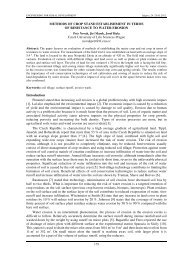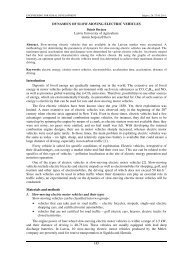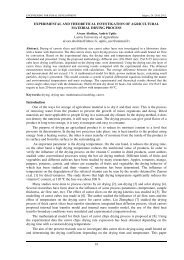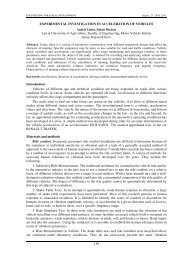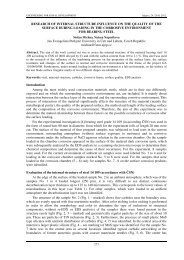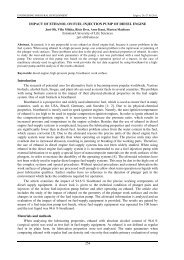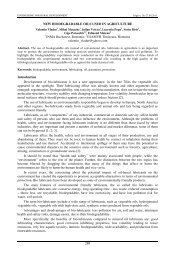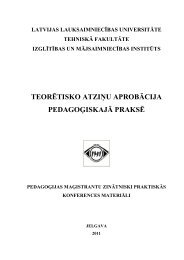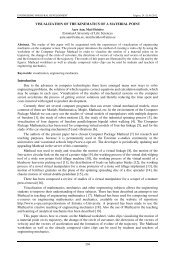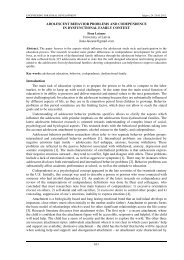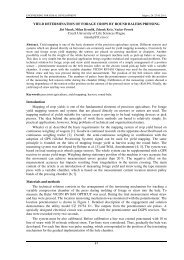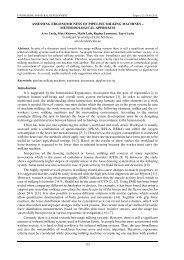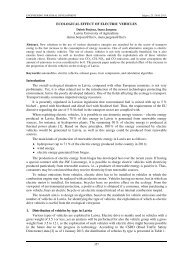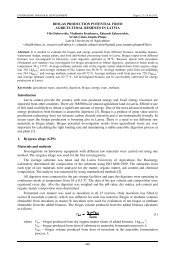Pavel Kic, Milan Zajicek Czech University of Life Sciences Prague
Pavel Kic, Milan Zajicek Czech University of Life Sciences Prague
Pavel Kic, Milan Zajicek Czech University of Life Sciences Prague
- No tags were found...
You also want an ePaper? Increase the reach of your titles
YUMPU automatically turns print PDFs into web optimized ePapers that Google loves.
ENGINEERING FOR RURAL DEVELOPMENT Jelgava, 26.-27.05.2011.NEW METHODS IN EDUCATION OF HVAC FOR ERABEE<strong>Pavel</strong> <strong>Kic</strong>, <strong>Milan</strong> <strong>Zajicek</strong><strong>Czech</strong> <strong>University</strong> <strong>of</strong> <strong>Life</strong> <strong>Sciences</strong> <strong>Prague</strong>; Academy <strong>of</strong> Science <strong>of</strong> the <strong>Czech</strong> Republickic@tf.czu.cz, zajicek@utia.cas.czAbstract. The paper describes the new approach to the education <strong>of</strong> the course focused on heating, ventilationand air-conditioning in the frame <strong>of</strong> MSc. study programs specialized on Agricultural and BiosystemsEngineering. Special attention is paid to the new methods <strong>of</strong> individual study with e-learning, modern methods<strong>of</strong> designing with use <strong>of</strong> specialized and also commercial s<strong>of</strong>tware and programs (e.g. CFD Fluent, OpenFOAMetc.). Seminars and laboratory work complete the education with practical or experimental measurements <strong>of</strong> allmain microclimatic parameters (thermal state, purity <strong>of</strong> air, noise, illumination etc.) and individual designsprepared by the students during the semester and presented by the students in seminars <strong>of</strong> the group at the end <strong>of</strong>semester, before the examination period. Lectures and seminars cover all principal problems related to thebuildings and equipment in agriculture and Biosystems engineering.Keywords: agriculture, study program, course, microclimate, ventilation, design.IntroductionEducation specialized to agricultural engineering has a long tradition in the <strong>Czech</strong> Republic.During the last decades great changes <strong>of</strong> the economy and policy in the country resulted also inchanges <strong>of</strong> the educational system. Many universities decided to prepare new study programmesaccording to the priorities and interests <strong>of</strong> young generation.Currently, after the many changes provided during the nineties and the first years <strong>of</strong> this century,the Faculty <strong>of</strong> Engineering educates graduates for the whole <strong>of</strong> the agri-food sector includingdesigning <strong>of</strong> technological equipment <strong>of</strong> buildings in food industry and agriculture, for roadautomobile transport and for trade and business involving machinery.Three year Thematic Network entitled Education and Research in Biosystems or Agricultural andBiological Engineering in Europe; a Thematic Network (ERABEE TN) has connected Universitiesactive in these problems from all European countries including several non EC countries. Participationhelped to exchange the information and prepare some new ideas for development and better educationin all active countries [1]. New curricula and methods for education and research were proclaimed.The paper is focused on s<strong>of</strong>tware equipment, which is used during the course focused on heating,ventilation and air-conditioning.Materials and methodsTwo kinds <strong>of</strong> s<strong>of</strong>tware are discussed here. The first one is the Moodle. The Moodle is an OpenSource Course Management System (CMS), also known as a Learning Management System (LMS) ora Virtual Learning Environment (VLE). It has become very popular among educators around theworld as a tool for creating online dynamic web sites for their students [2]. To work, it needs to beinstalled on a web server somewhere, either on one <strong>of</strong> your own computers or one at a web hostingcompany. There are two ways the Moodle is used. The first is the place, where students can find theappropriate materials as, for example, texts and presentations with individual themes prepared by theteacher. The second way allows students to manage their own projects considering the educationschema and individual projects.The second kind <strong>of</strong> s<strong>of</strong>tware used during the course is the Computer Fluid Dynamics CFDs<strong>of</strong>tware. Students are familiarized with an Open source CFD package OpenFoam [3] and commercialCFD product Fluent [4]. Both <strong>of</strong> them are able to solve the wide range <strong>of</strong> problems from the HVACfield.The plan <strong>of</strong> the exercises is prepared to lead the students through the whole cycle <strong>of</strong> the numericalanalysis. It starts with the measurement in real buildings, where it is possible to see the measurementtechniques and practical limits <strong>of</strong> the used devices, e.g., thermovision camera IR Flexcam Pro, mobileweather station, Ahlborn measuring instruments and sensors with ALMEMO connectors formeasurement <strong>of</strong> all main parameters needed for this area <strong>of</strong> research and education, e.g., temperaturesensors with NiCr-Ni thermocouples, Pt100 and NTC, thermowires and compensation lines, capacitive20
ENGINEERING FOR RURAL DEVELOPMENT Jelgava, 26.-27.05.2011.humidity sensors, psychrometer, thermoanemometers, air flow, comfort index measurement in roomconditions, WBGT measurement, measuring thermal transmittance and heart flow for buildingphysics, sensors for measuring moisture in materials, surface temperature, soil humidity measurement,global radiation, light, luminous intensity, gas concentration in air (oxygen, carbon dioxide, carbonmonoxide, ammonia, hydrogen sulphide, etc.The student projects are based on real dimensions <strong>of</strong> the existing buildings or machines and theneeded simplifications are made to the corresponding geometries and models. The students are led touse the OpenFoam s<strong>of</strong>tware for solving them. Some projects are also solved using the Fluent and thecomparison <strong>of</strong> the results for such cases is done and discussed.The geometry which corresponds to the transversal shape <strong>of</strong> the broiler house [5] can be seen atFigure 1. It is a rectangle with two inlets (windows on the right side) and one outlet (the ventilator onthe left side), it corresponds to a more generalized case <strong>of</strong> transversal ventilation which is <strong>of</strong>ten usedas a ventilation schema at animal houses.Fig. 1. Typical geometry used as a student project case: All distances are given in meters. The level<strong>of</strong> measurement is the height above the floor, where the measurement at real objects was made. Theheat source represents the heat generated by poultryIt has to be mentioned, that there are completely different needs for the ventilation system duringthe summer and winter period. During the winter, the internal space <strong>of</strong> the broiler house is heated byadditional heat sources and the amount <strong>of</strong> incoming fresh air has to be preheated before the fresh airreaches the zone <strong>of</strong> animals to prevent their undercooling. It means that the amount <strong>of</strong> the incoming airis relatively small and is limited by the critical values <strong>of</strong> humidity and pollutant (CO 2 , NH 3 )concentration. During the summer period the amount <strong>of</strong> air depends mainly on the maximumtemperature, which is reached at the zone <strong>of</strong> animals to prevent overheating <strong>of</strong> them.It is clear, that the shape <strong>of</strong> the flow field is influenced by many parameters, but one <strong>of</strong> the mostimportant is the direction <strong>of</strong> the incoming air stream. Therefore, the analysis <strong>of</strong> the temperature pr<strong>of</strong>ileat the level <strong>of</strong> measurement can be very important and can be done relatively easily with CFD and it isa typical exercise for students’ work.Fig. 2. OpenFoam toolbox structure: All data processing and manipulations can be done using a part<strong>of</strong> this toolbox either with benefits <strong>of</strong> external programs (e.g., mesh generators, visualisation products,user defined inputs <strong>of</strong> data ...)The structure <strong>of</strong> the OpenFoam s<strong>of</strong>tware can be seen in Figure 2. The OpenFoam geometrydefinition file is shown in Figure 3. It is clear, that the definition is a poor text file with the definition<strong>of</strong> points, edges and boundary parts. The physical properties, solver setup and other parameters <strong>of</strong> themodel have to be defined in a similar way. This attempt is not so user friendly, but is very useful, forunderstanding the problem and thinking about physical background <strong>of</strong> the given case. For example,21
ENGINEERING FOR RURAL DEVELOPMENT Jelgava, 26.-27.05.2011.the definition <strong>of</strong> any physical unit is given as a value and vector which represents the SI expression inbasic units. For example, the pressure is given in Pascals p=72 (Pa) written as:p [1 -1 -2 0 0 0 0] 72; where the vector after p corresponds to the power <strong>of</strong> the basic units at thetranscription <strong>of</strong> the derivative unit. For Pascals the basic unit transcription is kg1·m -1·s -2 .K 0 kmol 0 A 0 cd 0 . This attempt is clear from mathematical point <strong>of</strong> view, but is not so user friendly.When you start to solve the same case using the Fluent s<strong>of</strong>tware, there is no need for editing anytext files, but you have to be familiar with a CAD-like pre-processor Gambit, which is a tool that canimport the complex geometry from almost all CAD systems and prepare it for the CFD analysis.Gambit also can stay as an independent geometry and mesh generator, which is the way it can be usedfor preparing the case shown here. The main benefit <strong>of</strong> Fluent is only one graphical interface, which isused for all activities you like to do with the s<strong>of</strong>tware, from defining the boundary conditions up tovisualisation.Once the model is meshed with fully defined boundary conditions, it is possible to run the solverand wait for the results. The shape <strong>of</strong> solution is obviously dependent on the solver algorithm andtherefore it is needed to compare the calculated values with the measurement. This part <strong>of</strong> work isusually very time consuming and takes a lot <strong>of</strong> energy. When the correct model is chosen and isconverged, here is the time for starting with analysis <strong>of</strong> the flow variants. The case from Figure 1 canbe an example analyzed according to different inlet stream directions.Fig. 3. OpenFoam geometry source code corresponding to Fig. 1: The three vertical dots mean thelines excluded from the file to decrease the size <strong>of</strong> the picture. There are 28 vertices in this geometryin the matter <strong>of</strong> factResults and discussionThere are a lot <strong>of</strong> parameters, which can be changed even on relatively simple geometry andboundary conditions presented here. The input stream direction is the only parameter which is changedduring the simulation. All other parameters <strong>of</strong> the model are the same at all calculations which arediscussed bellow. Figure 4 shows the velocity contours for two inlet configurations. The uppersimulation corresponds with the situation, when only the up inlet is open and the direction <strong>of</strong> the flow22
ENGINEERING FOR RURAL DEVELOPMENT Jelgava, 26.-27.05.2011.is 30º. The bottom result shows the velocity field when both inlets are used, the flow from the downinlet has a direction 30º and the flow from the up inlet has a direction 60º. The angle is measured fromthe right wall, e.g., 0º means the direction down and 180º means the direction UP.0.4 m·s -10 m·s -1Fig. 4. Comparison <strong>of</strong> two velocity pr<strong>of</strong>iles for the same flowrate. The upper corresponds to onlythe upper window open and the direction <strong>of</strong> the input stream 60º. The lower case shows the changewhen both inlets are open and the input stream <strong>of</strong> the down inlet has the direction 30º.It is seen, that there an uncountable amount <strong>of</strong> variants can arise, which can be solved andtherefore it is very important to find some criteria, which can give a brighter idea about comparison <strong>of</strong>them. Fig. 5 illustrates the comparison <strong>of</strong> the velocity and temperatures pr<strong>of</strong>iles for 10 cases withchangeable inlet position and directions <strong>of</strong> the inlet flow. All pr<strong>of</strong>iles are obtained from the same line(level 0.3 m above the floor).Velocity pr<strong>of</strong>iles – Input DOWNVelocity pr<strong>of</strong>iles – Input UPVelocity, m·s -1Velocity, m·s -1Longitudinal distance, mTemperature pr<strong>of</strong>iles – Input DOWNLongitudinal distance, mTemperature pr<strong>of</strong>iles – Input UPTemperature, ºCTemperature, ºCLongitudinal distance, mLongitudinal distance, mFig. 5. Typical results <strong>of</strong> CFD analysis <strong>of</strong> variants. The comparison <strong>of</strong> the velocity and temperaturepr<strong>of</strong>iles at the level <strong>of</strong> measurement. The angle <strong>of</strong> the input stream is the parameter <strong>of</strong> these graphs. 90degrees mean that the input flow is horizontal. Lower angles mean that the intake air goes down;higher values mean that it goes up23
ENGINEERING FOR RURAL DEVELOPMENT Jelgava, 26.-27.05.2011.There can be observed some basic properties <strong>of</strong> the system behavior, which has to correspondwith the physical principles. For example, it is clean, that the input stream at the same direction causeshigher velocities at the animal zone when it is coming from the down inlet, than that, which is comingform the upper one. It is clear, that there is a greater rise <strong>of</strong> temperatures at the flow with smallervelocity or with recirculation.This set <strong>of</strong> pictures is a typical kind <strong>of</strong> a result, which can be expected as an output from thestudent projects. It should be also mentioned, that the amount <strong>of</strong> the possible applications <strong>of</strong> CFDsimulations in Biosystems or Agricultural and Biological Engineering is practically inexhaustible.Every process which has a deal with fluid flow and energy transport can be simulated (withappropriate simplifications) and the results can be used for the process improving.A short comparison <strong>of</strong> OpenFoam and Fluent is made in Table 1. It is not easy to compare thedetailed level <strong>of</strong> models and solvers implemented inside each <strong>of</strong> these s<strong>of</strong>tware products. But there canbe one general advice given. If the user is a scientist or student, who has time to prepare his model inevery detail and aspect, and likes to learn about the principles <strong>of</strong> CFD, the OpenFoam is ideal for him.It is free and open.If the user needs to solve complex and large problems with precise pre- and post-processing or ifhe needs to spare his time, the Fluent is only choice. Not free, but a very user friendly arranged systemwith a support from ANSYS brings well done user guides and lot <strong>of</strong> functions, which are accessiblethrough one graphical user interface, with included a large material properties database and interfacesfor using this s<strong>of</strong>tware together with many common CAD systems.Table 1Comparison <strong>of</strong> OpenFoam and FluentFeature Open Foam FluentToolbox which can be used formaking and solving the problem(set <strong>of</strong> libraries)Main characteristicsLicensingPre-processingMesh generationSolversPostprocessingLibrary <strong>of</strong> physicalproperties <strong>of</strong> materialsTime to make anumerical model andsolve the comparableproblemFree download, install and useSimilar to the programmingcodeAs a part <strong>of</strong> the definition codeA number <strong>of</strong> independentsolversParaFoam – the graphicalfrontend which can visualize thecalculated data.nodaysComplex GUI driven s<strong>of</strong>twarewith robust pre- andpost-processingCommercial license, pricing perprocess, lover prices for academicand research institutions.User friendly geometrical CADlike pre-processor Gambit withintegrated mesh generator.Automatic widely configurablemesh generatorSolvers easily configurable fromGUIVery robust and pr<strong>of</strong>essionallyequipped, included directly intothe FluentyeshoursConclusionsThe education process <strong>of</strong> the Agricultural and Biosystems Engineering has a lot <strong>of</strong> aspects, whichcan be supplementary supported by CFD simulations. For students it is very useful to recognise thepossibilities <strong>of</strong> numerical simulation <strong>of</strong> the thermal analysis and fluid flow during the course. Theknowledge <strong>of</strong> the basic principles <strong>of</strong> s<strong>of</strong>tware such as OpenFOAM can be very useful for the diplomathesis <strong>of</strong> the students and also for their pr<strong>of</strong>essional lives.24
ENGINEERING FOR RURAL DEVELOPMENT Jelgava, 26.-27.05.2011.References1. <strong>Kic</strong> P., Jurča V. Restructuring agricultural/biosystems engineering studies and employability inthe <strong>Czech</strong> Republic. In: Restructuring agricultural/biosystems engineering studies andemployability in Europe. Athens, 2006, pp. 30-35, ISBN 960-89313-0-42. Vanova T., Vanova A. Moodle in the Net, Pragodata Consulting, <strong>Prague</strong>, 2009, ISBN 978-80-7399-447-1 (in <strong>Czech</strong>)3. Fluent brochure. [online] [10.03.2011]. Available at: http://www.ansys.com/staticassets/ANSYS/staticassets/resourcelibrary/brochure/ansys-fluent-brochure.pdf4. The open source CFD toolbox OpenFoam – User guide. [online] [10.03.2011]. Available at:http://www.openfoam.com/docs/user/5. <strong>Kic</strong> P., <strong>Zajicek</strong> M., Broiler house ventilation, CFD analysis <strong>of</strong> variants. In: Proceedings <strong>of</strong> the 3rdInternational Congress on Information and Communication Technologies in Agriculture, Food,Forestry & Environment (ITAFFE’10), edit by Zeynel Cebeci, Ondokuz Mayis <strong>University</strong>,Samsun, Turkey, 2010, pp. 126-131.25



